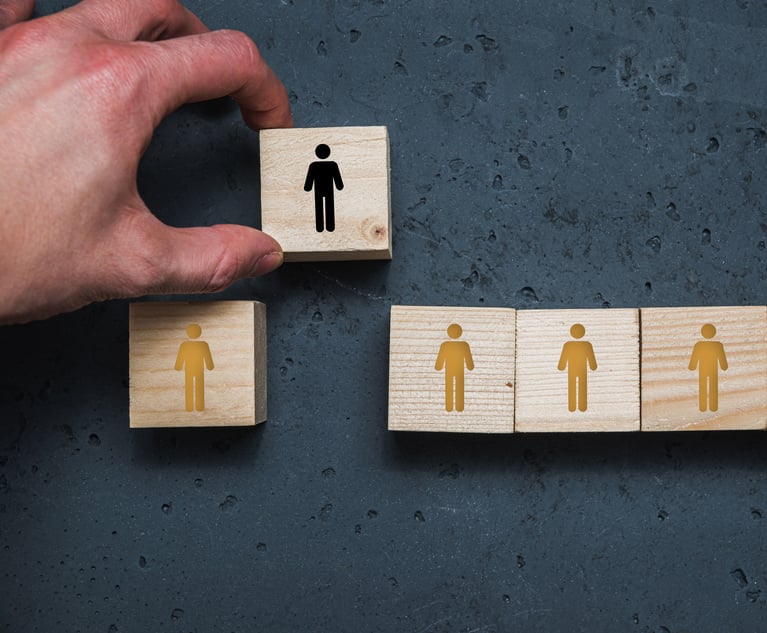Women's Soccer Gets Rematch in Court With Unequal Pay Class Action
The class action, which alleged that the U.S. Soccer Federation pays women players less than their male counterparts, caps a lengthy feud over pay.
March 11, 2019 at 06:31 PM
5 minute read
 Carli Lloyd, Bill de Blasio, Megan Rapinoe and Jill Ellis attend New York City Ticker Tape Parade for World Cup Champions U.S. Women Soccer National Team on Broadway, on July 10, 2015. Photo: Shutterstock
Carli Lloyd, Bill de Blasio, Megan Rapinoe and Jill Ellis attend New York City Ticker Tape Parade for World Cup Champions U.S. Women Soccer National Team on Broadway, on July 10, 2015. Photo: Shutterstock
A gender discrimination class action against the U.S. Soccer Federation kicks to the courts a long-simmering conflict over pay disparities in the professional sport, just as a venue fight flares in a related case.
The class action, filed three months before the FIFA Women's World Cup, alleges that the U.S. Soccer Federation pays members of the U.S. Women's National Team less than their male counterparts. The lawsuit was filed March 8 by 28 team members under Title VII of the Civil Rights Act and the Equal Pay Act, which requires class members to opt into the case, brought on behalf of current and former team members starting in 2015.
The case caps a lengthy feud between the U.S. Soccer Federation and the women's soccer team, winner of the Women's World Cup in 2015 and ranked No. 1 in the world. On Aug. 24, former goalkeeper Hope Solo filed her own suit against the U.S. Soccer Federation for the same claims.
“The women, starting in 2004, have always asked for equal pay,” said Solo's attorney, Richard Nichols, who was executive director and general counsel of the U.S. Women's National Soccer Team Players Association, which negotiates for the team's collective bargaining agreement, in 2015 and 2016. “U.S. Soccer has said no.”
Solo and four other players filed a discrimination charge in 2016 with the U.S. Equal Employment Opportunity Commission. The class action includes the other four women, who received notices of right to sue from the EEOC last month.
The suit, filed by Jeffrey Kessler, the same attorney who represented the women in the EEOC charge, comes as the U.S. Soccer Federation has moved to transfer Solo's case from California to Illinois, where its headquarters are in Chicago. A federal judge in San Francisco heard arguments on that motion last month.
Nichols, a solo practitioner in Novato, California, said he did not want his case in Illinois, where the U.S. Soccer Federation won a declaratory judgment against the women's players union in 2016 when the team threatened to go on strike just before the Olympics.
“Given that experience,” he said, “I would feel a lot better if this case was not adjudicated in Chicago.”
He conceded that the U.S. Soccer Federation's connections in California are mostly in Los Angeles, home to its national training camp. Los Angeles also is where attorney Kessler filed the class action. On March 8, Kessler, co-executive chairman of Winston & Strawn in New York, brought a motion to coordinate his case with Solo's lawsuit into a multidistrict litigation proceeding in Los Angeles, citing a “strong nexus” to the case.
Solo's case provides a glimpse into the U.S. Soccer Federation's possible legal defenses in the class action. In a Dec. 31 motion to dismiss Solo's case, the federation argued that compensation to players of the two teams were different: women receive a salary, while men's payments are per game. And each operated under separate collective bargaining agreements.
The Equal Pay Act applies to discrimination against women who work at the same “establishment” as men in jobs involving “substantially equal skill, effort and responsibility.”
“This is not a case where employees are working side-by-side, doing the exact same job, but getting paid differently for the same work,” wrote Ellen McLaughlin, a partner at Seyfarth Shaw in Chicago, who heads an all-women's legal team for the federation in the case. “Rather, this case takes two entirely different categories of professional athletes—athletes who play for different teams, have different obligations, are compensated in fundamentally different ways, and enjoy different benefits—and asks the court to conclude that they are suitable comparators for each other under the EPA.”
McLaughlin did not respond to a request for comment.
Nichols called that a “ridiculous argument.”
“U.S. Soccer is the single employer of the men's and women's teams,” he said. “The men and women do the same job under similar circumstances in similar venues under the same rules and regulations depicted by their employer, U.S. Soccer. There are no two separate establishments.”
As to the salary difference, he said, women had argued before for a pay-to-play system like that of male players, who get between $5,000 to $17,625 per game, but the federation wouldn't guarantee a number of games each year.
“Women needed to make sure they needed to make some money playing for the United States, and the only way to do that, for a guaranteed income, was to have a salary,” he said.
This content has been archived. It is available through our partners, LexisNexis® and Bloomberg Law.
To view this content, please continue to their sites.
Not a Lexis Subscriber?
Subscribe Now
Not a Bloomberg Law Subscriber?
Subscribe Now
NOT FOR REPRINT
© 2025 ALM Global, LLC, All Rights Reserved. Request academic re-use from www.copyright.com. All other uses, submit a request to [email protected]. For more information visit Asset & Logo Licensing.
You Might Like
View All
State Appeals Court Revives BraunHagey Lawsuit Alleging $4.2M Unlawful Wire to China
3 minute read

Apple Disputes 'Efforts to Manufacture' Imaging Sensor Claims Against iPhone 15 Technology

Lawsuit alleges racial and gender discrimination led to an Air Force contractor's death at California airfield
7 minute readTrending Stories
- 1Pa. High Court: Concrete Proof Not Needed to Weigh Grounds for Preliminary Injunction Order
- 2'Something Else Is Coming': DOGE Established, but With Limited Scope
- 3Polsinelli Picks Up Corporate Health Care Partner From Greenberg Traurig in LA
- 4Kirkland Lands in Phila., but Rate Pressure May Limit the High-Flying Firm's Growth Prospects
- 5Davis Wright Tremaine Turns to Gen AI To Teach Its Associates Legal Writing
Who Got The Work
J. Brugh Lower of Gibbons has entered an appearance for industrial equipment supplier Devco Corporation in a pending trademark infringement lawsuit. The suit, accusing the defendant of selling knock-off Graco products, was filed Dec. 18 in New Jersey District Court by Rivkin Radler on behalf of Graco Inc. and Graco Minnesota. The case, assigned to U.S. District Judge Zahid N. Quraishi, is 3:24-cv-11294, Graco Inc. et al v. Devco Corporation.
Who Got The Work
Rebecca Maller-Stein and Kent A. Yalowitz of Arnold & Porter Kaye Scholer have entered their appearances for Hanaco Venture Capital and its executives, Lior Prosor and David Frankel, in a pending securities lawsuit. The action, filed on Dec. 24 in New York Southern District Court by Zell, Aron & Co. on behalf of Goldeneye Advisors, accuses the defendants of negligently and fraudulently managing the plaintiff's $1 million investment. The case, assigned to U.S. District Judge Vernon S. Broderick, is 1:24-cv-09918, Goldeneye Advisors, LLC v. Hanaco Venture Capital, Ltd. et al.
Who Got The Work
Attorneys from A&O Shearman has stepped in as defense counsel for Toronto-Dominion Bank and other defendants in a pending securities class action. The suit, filed Dec. 11 in New York Southern District Court by Bleichmar Fonti & Auld, accuses the defendants of concealing the bank's 'pervasive' deficiencies in regards to its compliance with the Bank Secrecy Act and the quality of its anti-money laundering controls. The case, assigned to U.S. District Judge Arun Subramanian, is 1:24-cv-09445, Gonzalez v. The Toronto-Dominion Bank et al.
Who Got The Work
Crown Castle International, a Pennsylvania company providing shared communications infrastructure, has turned to Luke D. Wolf of Gordon Rees Scully Mansukhani to fend off a pending breach-of-contract lawsuit. The court action, filed Nov. 25 in Michigan Eastern District Court by Hooper Hathaway PC on behalf of The Town Residences LLC, accuses Crown Castle of failing to transfer approximately $30,000 in utility payments from T-Mobile in breach of a roof-top lease and assignment agreement. The case, assigned to U.S. District Judge Susan K. Declercq, is 2:24-cv-13131, The Town Residences LLC v. T-Mobile US, Inc. et al.
Who Got The Work
Wilfred P. Coronato and Daniel M. Schwartz of McCarter & English have stepped in as defense counsel to Electrolux Home Products Inc. in a pending product liability lawsuit. The court action, filed Nov. 26 in New York Eastern District Court by Poulos Lopiccolo PC and Nagel Rice LLP on behalf of David Stern, alleges that the defendant's refrigerators’ drawers and shelving repeatedly break and fall apart within months after purchase. The case, assigned to U.S. District Judge Joan M. Azrack, is 2:24-cv-08204, Stern v. Electrolux Home Products, Inc.
Featured Firms
Law Offices of Gary Martin Hays & Associates, P.C.
(470) 294-1674
Law Offices of Mark E. Salomone
(857) 444-6468
Smith & Hassler
(713) 739-1250






